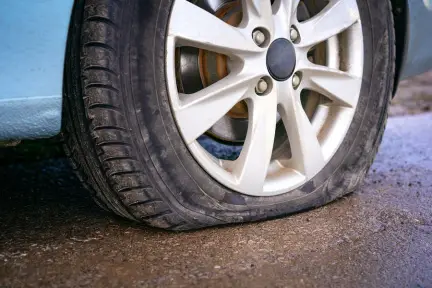
Tire Blowout or failure is a word that sends shivers down to the spine of every driver. Though with the improvement in the quality of tires, their durability has increased, and the chance of a tire blowout has been reduced. But they can still occur no matter how slight the chance. Not many people know how to handle a tire blowout, and it can cause panic in drivers.
What Is a Tire Blowout?
What actually is a blowout? Due to low air pressure(or sudden loss in pressure), the tire gets flexed more than its capacity and bursts with a loud boom. It might sound like an explosion.
After the explosion, the car jerks, and it feels like some is pulling it left or right side of the road. There are many reasons it can happen other than low air pressure within the tire, like extreme heat, overloading, impact damage, or a combination of these conditions. So we can say that the main culprit is the extra strain the construction of a tire has to bear.
Let's go through the causes of blowout first, and at last, I will give you tips on handling one.
What Causes a Tire Blowout?
Underinflation
People mostly think that overinflation is the cause of a blowout. However, in reality, it is underinflation that causes it. Due to low air pressure, the shape of the tire changes, stretching it beyond its limits, and it is even unable to support the vehicle's weight.
Follow the manufacturer's guidelines and always check your car's tire pressure measuring system (TPMS). There are many other reasons a tire can blow out. Make sure to reduce the variables as much as you can.
Overloading
Having a sturdy truck does not mean that you can load all the world on it. There are guidelines and load limits that a truck or, more specifically, its tires can handle. Crossing that limit will squish the tire causing it to overheat quickly. You can imagine what will happen next.
Extreme Heat
Heat does not directly rupture the tire, but it is a significant contributor in causing tire blowouts. Most of such incidents occur during summer due to the combination of overloading and heat.
Impact Damage
Impact damage can put severe pressure on a tire's internal structure and can cause it to blow.
How to Drive Through a Blowout
The sudden explosion and limping of the car will give you the impression that you are hit by something you can't see. It is very easy for drivers to panic and lose control of the vehicle. Here are some tips to help you drive through a blowout safely.
- First of all, stay calm so you can make a rational decision.
- Do not press the brakes reflexively. It will lock your tires, and there is a chance your car will spin out.
- Keep your steering straight, keep your leg on the accelerator and press it slightly. This will help you in keeping the vehicle under control.
- When everything is under control, slowly take your feet off the accelerator.
- Turn on the emergency lights.
- Steer the car to the road's shoulder after decelerating safely.
But keep in mind that " Prevention is Better than Cure."
Same articles

Understanding Vehicle Inspection and Verification Services: Why They Matter for Every Driver
GuidesVehicle inspection and verification services are an essential but often overlooked part of keeping roads safe and cars legally compliant. Most people only think about inspections when it’s...
KLIFEX Brand Overview: High-Quality Automotive Repair Kits for Affordable Repairs
GuidesThe automotive aftermarket has long needed solutions that combine reliability, durability, and affordability. Many car enthusiasts and services are looking for a way...
Fast, Reliable Vehicle Emissions & Inspection Services Made Simple
GuidesFast, reliable emissions and inspection services are essential for keeping vehicles road-ready, compliant with environmental regulations, and safe for daily driving. If you’re looking for quick...

